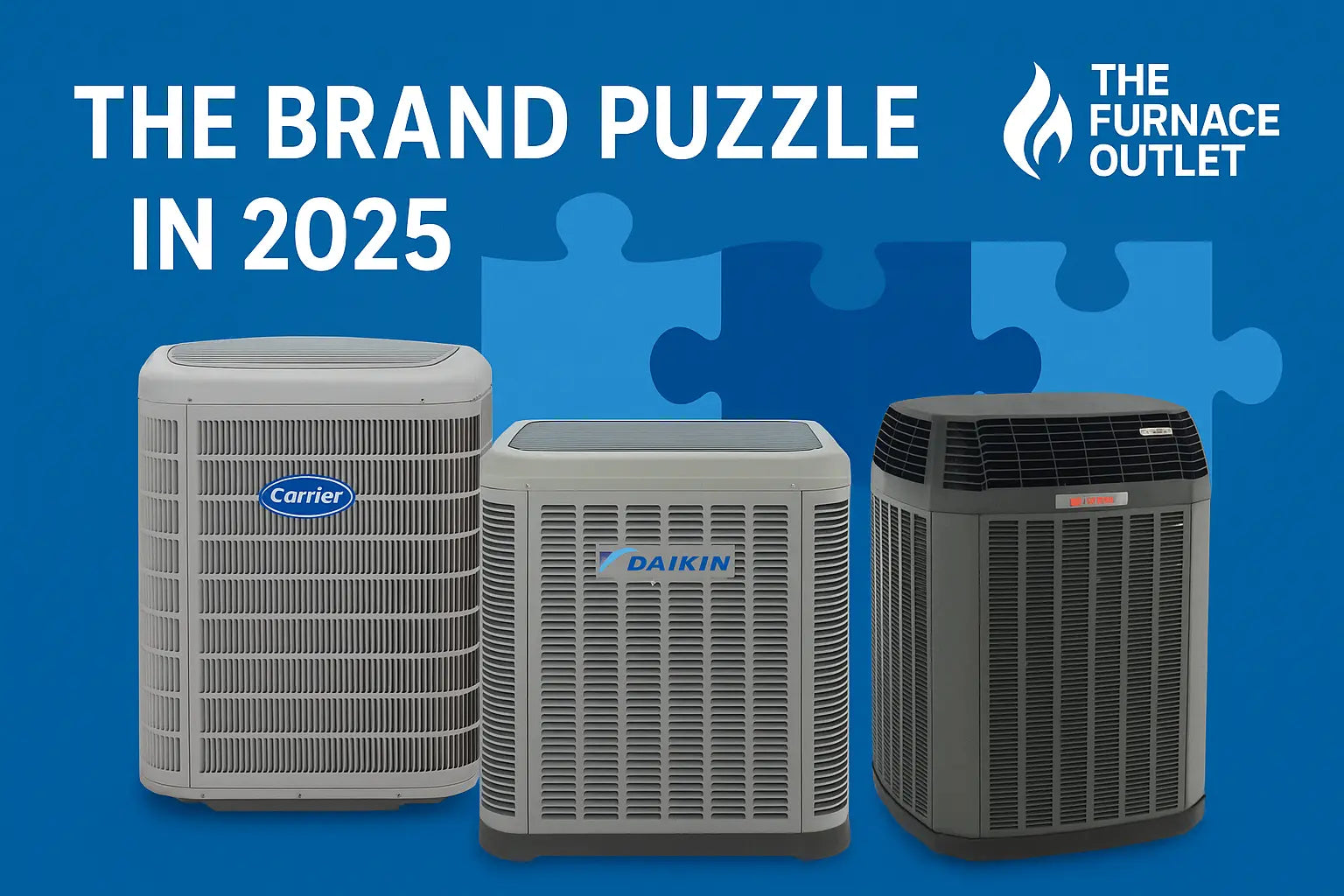Key Takeaways
-
Carrier, Trane, and Lennox = top reliability and high SEER2.
-
Goodman and Amana offer lifetime compressor warranties.
-
Daikin is growing fast with SEER2 up to 23 and 12-year parts coverage.
-
Proper sizing, install quality, and warranty terms matter too.
-
Register within 60 days and keep install proof for full warranty.
The Brand Puzzle in 2025
Imagine buying a car that needs to run every summer day for 15 years without breaking down. That is what your central air conditioner does. In 2025, U.S. homeowners face more choices than ever, from high-end Carrier Infinity units to budget-friendly Goodman systems. This article breaks down how the top brands stack up on reliability, warranty, efficiency, and real-world owner happiness. You will also see why new SEER2 rules matter for your power bill and how to dodge costly sizing mistakes. By the end, picking the right brand—and the right installer—will feel a lot less confusing.
Explore AC + gas furnace systems with strong warranties and full coverage options.
The Common Problem: Picking a Unit That Lasts
The number-one worry people share in forums and service calls is simple: “Will my new AC quit after the warranty ends?” Repairs often cost thousands because compressors and evaporator coils are hard to reach and packed with refrigerant. Choosing the wrong brand—or letting anyone size it by guesswork—can shorten equipment life, raise bills, and void the warranty. Knowing where each brand really stands on failure rates and policy fine print helps you avoid that headache.
How We Rated Each Brand
To rank the ten leading names, we compared independent technician surveys, AHRI performance data, and published warranties. Reliability earned the most weight, followed by warranty length, maximum SEER2, and owner reviews collected after at least five cooling seasons. We then double-checked each claim against brand spec sheets and EnergyGuide labels. For deeper details on efficiency labels, read our SEER2 and AFUE guide.
Reliability Results: Carrier, Trane, Lennox Lead
Carrier, Trane, and Lennox show the fewest out-of-warranty compressor failures. Carrier’s Infinity 26 uses a variable-speed scroll compressor that ramps gently, reducing stress. Trane’s Climatuff design and Lennox’s Precision-Balance fan blades also cut vibration. American Standard (owned by Trane) shares many components, so its reliability is nearly identical. Goodman and Amana rank “good,” not “excellent,” yet their parts are widely available and cheaper to replace, which keeps repair bills manageable.
Compare top-rated SEER2 condensers for reliable cooling and long-term savings.
Warranty Breakdown: Lifetime vs. Ten Years
A warranty is only words until something fails, but longer terms still add peace of mind. Goodman and Amana promise lifetime compressor replacement on select models, a rare perk in HVAC. Trane and American Standard offer up to 12 years on compressors when registered. Carrier, Lennox, Rheem, York, and Daikin give 10-year parts coverage, with optional labor plans sold through dealers. Always register online within two months and save the confirmation email; missing that step can chop the term in half. For cost context, see our installation price breakdown for a 3-ton system
Energy Efficiency Spotlight: SEER2 Champions
The 2023 switch to SEER2 testing raised external-static pressure, making the numbers closer to real attics and duct runs. Lennox’s SL28XCV tops the market at 28 SEER2. Carrier’s Infinity 26 reaches 24 SEER2, while Trane’s XV20i and Daikin’s DX20VC hover around 22–23. Higher SEER2 means fewer kilowatt-hours, but look at EER too if you live in hot, dry regions where the unit runs at full blast. Our post on SEER2 vs. EER
Customer Feedback: Quiet, Comfort, and Issues
Surveys show Carrier, Trane, and American Standard owners rate sound levels “excellent.” Lennox earns marks for comfort but sometimes loses points when proprietary parts delay repairs. Goodman and Amana reviews vary by installer skill—units placed on oversized linesets or charged incorrectly tend to fail early. Daikin’s inverter compressors impress users with near-silent night operation, boosting its score each year. For more on everyday owner experiences, check our complete brands guide
Budget vs. Premium: Which Tier Fits You
Premium systems cost more upfront but can pay back through lower energy bills and longer life if you plan to stay in the home ten years or more. Budget lines like Goodman often reach a “sweet spot” of 14.5–16 SEER2 where savings flatten compared with the higher-priced options. Our article on the 14.5 SEER2 sweet spot shows the math Remember to balance sticker price against warranty strength, expected lifespan, and local utility rebates.
Shop all-in-one packaged systems for simple installation and compact performance.
Action Plan: Steps to Secure the Right System
-
Run a Manual J load calc or use a reputable HVAC sizing calculator—never pick tonnage by square feet alone.
-
Short-list brands based on reliability and warranty goals from this article.
-
Check local rebates; high-SEER2 models can qualify for $200–$1,000 credits.
-
Interview installers: ask for NATE certification and manufacturer training proof.
-
Get bids in writing, including model numbers, line-set flushing, and permit fees.
-
Register the unit online within 60 days to lock in the full parts warranty.
Send a photo for a free quote—we’ll match the best unit for your home.
Frequently Asked Questions
Q: What is SEER2, and why did it replace SEER?
SEER2 uses tougher test conditions that mimic real ductwork, so the number better predicts your true energy cost.
Q: Are lifetime compressor warranties really lifetime?
They cover only the original homeowner and parts, not labor. Read the fine print to see if shipping or refrigerant is excluded.
Q: Does a higher SEER2 always save money?
Only if your climate has long, hot summers. In mild zones, the payback can be slow.
Q: Will a premium brand cool better than a budget one?
Cooling capacity is similar if both are sized correctly, but premium models modulate speed, cutting humidity and noise.
Q: How often should I service my new AC?
Twice a year: spring for cooling tune-up, fall for heating components if it is a heat pump. Regular checks keep the warranty valid.







